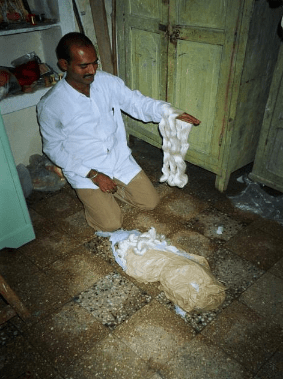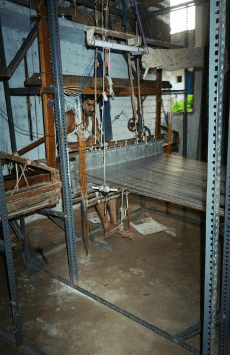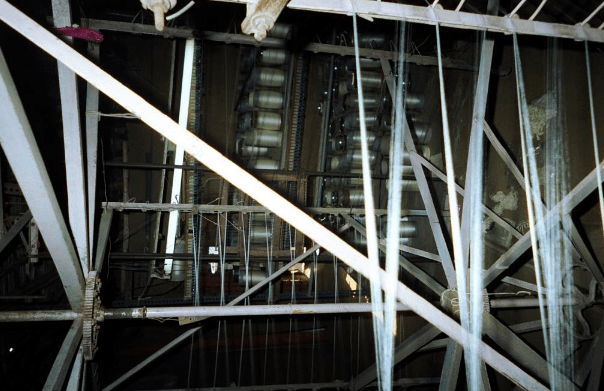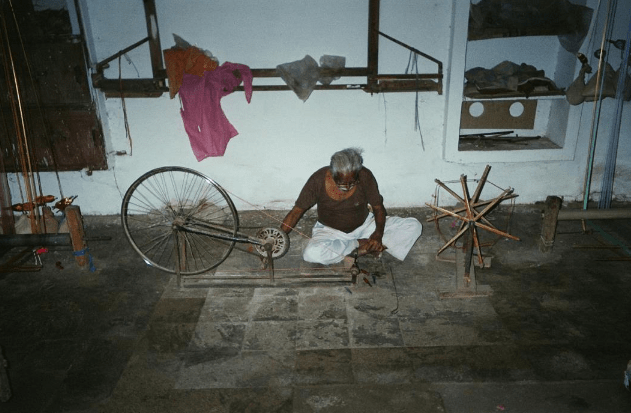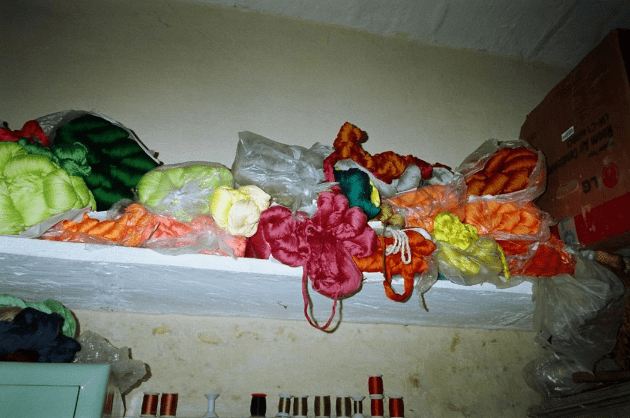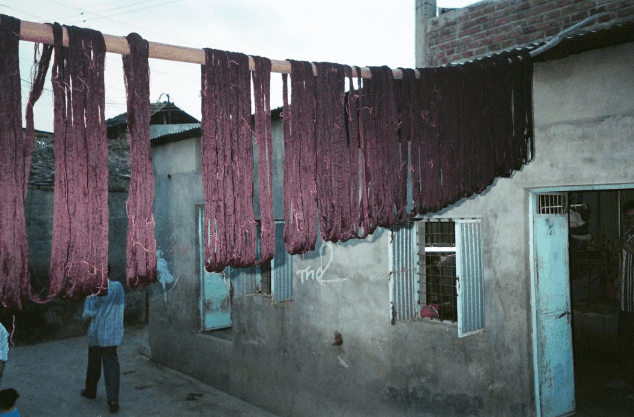Maheshwari Weaving
are you looking for the Maheshwari Weaving? then do check out this post to know Maheshwari weaving History, Regions, Materials, Tool, and Processes.
History of the Sari
The first proof of the Indian sari was found with the small statues of Sumer that go back to 2000-3000 B.C. This was the time of the Indus Valley Civilization.
There are many references to the sari in the premier works of Sanskrit literature. The Rig Veda… [which goes back to ] 1200 B.C. tells about the golden bright sari and perhaps about brocade. In the heroic poem of [the] Mahabharata, there is a reference to the pearl-embroidered sari.
Mural-paintings in the Ajanta caves featured the Bandana sari, or the warp and weft weave. This is in addition to dyed saris that were made of silk and cotton muslin. Sculptors of Ajanta particularly refer to the use of metrical models such as lines, angles, circles, squares, points, and curves in sari designs.
Maheshwar
Maheshwar is a small town on the banks of the river Narmada in the Dhar district of Madhya Pradesh. It is around 80 km from the Indore, the commercial capital of the state.
Maheshwar is an ancient town of pilgrimage with a rich heritage of art and culture. It has been mentioned in epics like the Mahabharata and Matsya Puran by the name Mahishmati. It is said that King Mahishman, who belonged to the Hyhay Dynasty, founded it.
The fort of Maheshwar was built during the rule of Mughal emperor Akbar. It reached its cultural zenith during the rule of the Holkar queen Devi Ahilya Bai (1767-95) who declared Maheshwar as her capital.
History of Maheshwari Handloom
Maheshwar, after becoming the capital of Devi Ahilya Bai Holkar’s state, witnessed many development efforts by the state. This included the construction of new temples, ghats, and other structures.
Devi Ahilya Bai also invited weavers from various princely states like Hyderabad, Mandav, and many more to settle in Maheshwar.
She supported these enterprises by purchasing a lot of their products for herself as well as for gifting to visiting dignitaries, a move that took the reputation of Maheshwari handloom to distant parts of India.
The weavers were asked to follow the designs inscribed on the walls of the fort. Even today these designs can be found on the borders of Maheshwari saris.
Thus, the handloom operations adopted since are being followed till date, including the use of only the natural fibers.
Global Presence of Maheshwari Weaving
The maheshwari saree, once an exclusive privilege of royalty, has now established a presence worldwide.
With maheshwari saree exports to countries all over the globe, including USA, UK, Canada, Australia, doubling and designers taking up the task of reviving the lost tradition, maheshwari weaving stands metamorphosed.
Textile tourism is emerging as one of the main reasons for the sustenance of the tradition of maheshwari weaving.
Regions of Maheshwar handloom production in India
Maheshwar handloom products are specialized and made only in Maheshwar. They have a unique traditional and cultural identity. However, some other areas of the country where silk saris are woven are:
1. Uttar Pradesh: Saris of Varanasi
2. Gujarat: Patola silk saris
3. Madhya Pradesh: Cotton and silk saris of Chanderi and Maheshwar
4. Tamil Nadu: Kanjivaram and Tanjore silk saris
5. West Bengal: Baluchari silk saris of Murshidabad
6. Andhra Pradesh: Sangareddy
7. Maharashtra: Paithani and Kosa silk saris
8. Orrisa: Sambhalpuri saris
Practitioner Community of Maheshwari Weaving
The handloom industry in Maheshwar employs people from various castes and religions, including Kshatriyas, Bharuds, Muslims, Kumhars, and Kahars. All these people are either from nearby areas or have migrated to Maheshwar and are now permanent residents there.
Maheshwari Weaving Materials
The raw material for Maheshwar handloom, mainly cotton, silk, and zari (golden wire), comes from different parts of the country.
Cotton
Cotton yarn for the weft is purchased from Coimbatore.
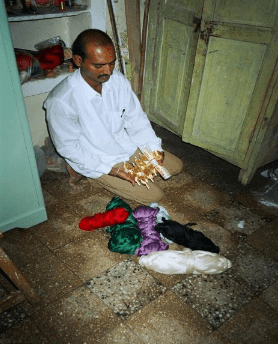
Silk
Mulberry Silk is used as the warp. This is purchased from dealers in Bangalore.
Zari
Zari is used mainly in weaving the beautiful borders of Maheshwar saris. This is procured from Surat (Gujarat)
Tools for Maheshwari Weaving
The various tools that are used in Maheshwari handloom are as follows:
Taana or Warp Machine
The warp machine is made of two basic parts. One is a big octagonal cylinder that rotates on its axis (which is very different from other warp machines in the sense that this cylinder is vertical), and the other is a vertical rack on which a number of thread rolls are placed.
The rolls pass to the cylinder of the machine through hooks under a constantly moving frame that helps wind the cylinder in a criss-cross manner.
Handloom
Two types of handlooms are used in Maheshwar —the older pit looms and the newer frame looms.
Pit Looms
These are the type of looms originally used for Maheshwari weaving since historical times. These heavy, wooden looms are installed inside a pit, about 3 feet deep. The weaver has to sit on the wall of this pit, with his legs inside. The looms are permanently installed in these pits and have hardly moved from their place for many years.
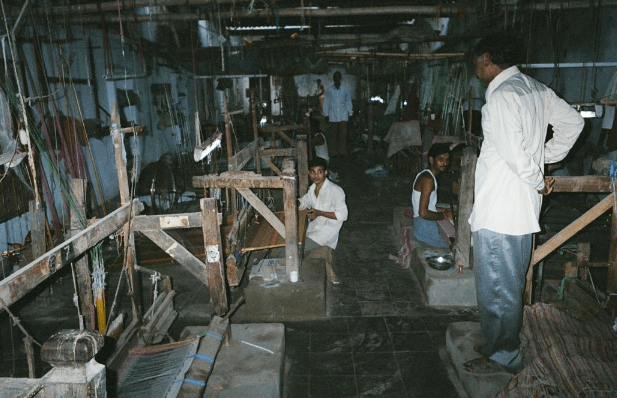
Frame Looms
These looms are the newer ones, with lightweight metal frames that constitute the main body. They have introduced hardly two to three years ago, and given their superior performance, have now been adopted by a large number of weavers.
This loom is superior to the older pit looms in the following ways:
- they are lightweight, requiring less effort by the weaver;
- they are easily detachable and therefore can be shifted for rearrangements etc.; and
- they have a pulley arrangement that gives better finishing to the borders of the sari.
Charkha
A charkha is used for making the rolls of thread. In case of warp, it is a big motorized one, which prepares big silk rolls. In case of weft, it is the smaller wooden one which prepares thin rolls called bobbins. These are put inside the shuttle to form the weft.
Dyeing Apparatus
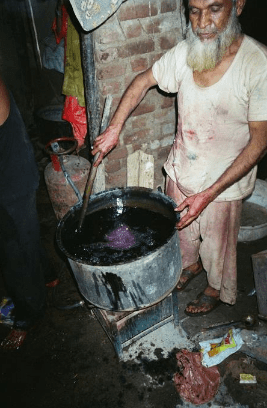
These mainly include various types of dyes and the tubs in which the dyeing is carried out.
Designs of Maheshwari Weaving
Maheshwari handlooms use a lot of traditional sari designs, many of which have been prevalent in the areas since historical times.
Many such designs are being used in their original form and many others with minor modifications in them. Interestingly, for the borders of the saris, the designs engraved on the walls of the Maheshwar fort are used.
Based on the design of the border, there are the following types of Maheshwari saris: Maheshwar bugdi kinar, zari patti, rui phool kinar, phool kinar, chatai kinar, V kinar, kahar kinar, bajuband kinar, etc.
Sometimes the designs are inspired from saris from other parts of the country. The design may depend on the order placed, which comes with the demand for a specific design.
Process of Maheshwari Weaving
The Maheshwari weaving process has the following steps:
Raw Material Procurement
Raw materials for the process (cotton, silk and zari) are procured from Bangalore, Coimbatore and Surat. They and are further processed to make suitable to work upon. These processes are discussed in detail in the following sections.
Dyeing
Dyeing is an important part of the whole process. Both cotton and silk require dyeing before they can be used on the loom.
The process is normally carried out by the weavers themselves or specialized dyeing technicians who charge for their services depending on the material and the kind of dyeing required.
There are different kinds of dyes for coloring silk and cotton. For coloring cotton thread, three types of dyes are used—napthol, wet dye and procion dye.
In case of cotton, dyeing is done not with a single dye but with a combination. For coloring silk, special dyes called Sando Silk are used, which are ready made dyes and do not need to be mixed with others.
The process of dyeing starts by dipping the raw threads in TR Solution (a combination of Turkish oil and bleaching powder) for at least four hours for bleaching.
This is followed by the actual process of dyeing. First, dyes are mixed in warm water in big metal tubs to obtain the desired colors. The threads are dipped in the tubs for a while and then dipped in the tank containing napthol to provide stability to the color.
They are then washed in other tanks containing plain water and then put in tubs containing solutions of detergent and soda in warm water. Thereafter, the threads are washed again and are hung on bamboo poles for drying. Once the threads are dry, they are sent back to the weavers for further processing.
Yarn Opening for Weft and Warp
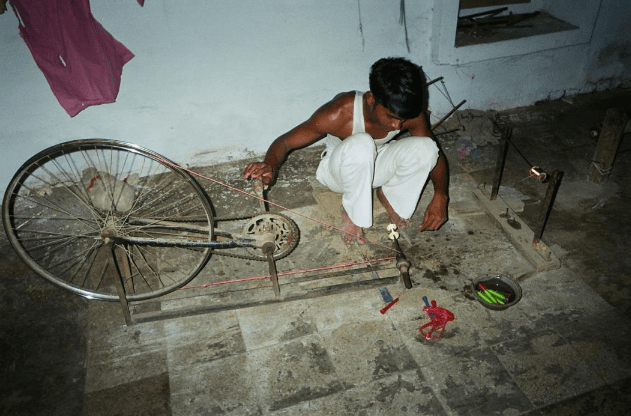
After dyeing, the yarn is normally received by the weavers in the form of bundles. Both in the case of weft and the warp, the thread needs to be freed from tangles and stretched in order to make them tighter.
They are then are taken through a process of reeling by using a charkha, thus converting the bundles into small rolls. In case of warp, a big motorized charkha is used; in case of weft, a small, hand-driven charkha is used, which makes bobbins.
Warping
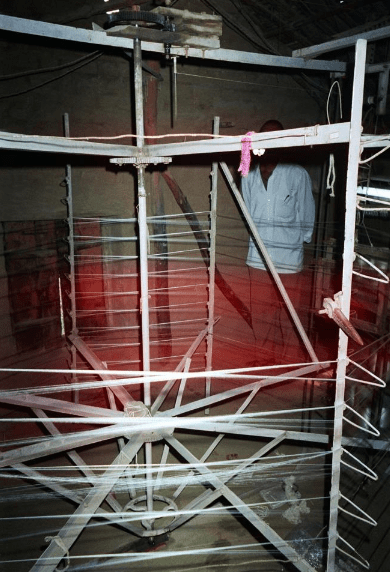
The master weaver carries out the process of making the warp. Since the silk fiber used is very delicate, the warp machine for the process is radically different from the one used in case of cotton thread.
The silk warp machine comprises an octagonal metal cylindrical frame that revolves vertically on the machine axis and a metallic rack on which the thread rolls are kept.
The fibers from these rolls pass through hooks fixed on the rack on to a double metallic frame that moves up and down with the motion of the machine, and are wound on the cylinder in a criss-cross manner that facilitates the detection of breach in the fiber, if one exists anywhere.
This process starts from one end of the cylinder and goes on till the whole of the cylinder is covered with the thread. Using this machine, the master weaver converts the raw silk into single or double fiber warp, depending on the requirement of the loom.
Once this has been achieved, the taana threads in the shape of bundles are taken to the loom where they are used as warp.
Weaving
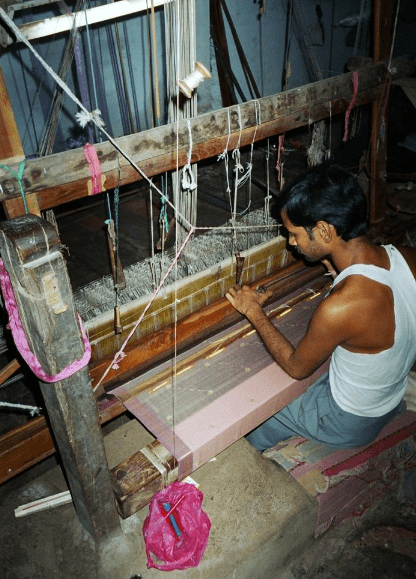
For weaving, one end of the warp is bound on main beam of the loom. The other end (in the form of a bundle) is taken under another horizontal beam parallel to the main beam and then across the overhead beam.
Weights are hung on it on the other end of the beam to keep it tight, giving the warp a Z-shape. There are up to 4,000 strings in a single warp. The length of warp is 50 meters and the width of weft is 48 inches.
As the warp proceeds, the bundle needs to be opened up. The movement of the string that controls the shuttle (in which the roll of weft thread is kept) takes the yarn of the weft across the threads of the warp. With the motion of the pedal, the heavy frame sets the yarn of the weft along the thread of the warp.
The weaver uses the zari threads and other colored threads across the warp depending on the desired design. The motion of the loom provides movement to the overhead jaquard-like punch card mechanism called dobby (although smaller than the jaquard looms, these have a similar function of putting forward particular hooks that are required for a particular border design) and helps in designing of the border of the sari.
The process of weaving is very difficult and tedious in case of saris that have more design work. Therefore, the resulting products are also proportionately expensive.
Finishing

Once a sari is completed, it is taken off from the loom and sent for cutting. The normal length of such a sari is about 11 feet. It is then folded properly and packed. No ironing or further printing is required. Once packed, they are ready to be marketed.
Products of Maheshwari Weaving
Maheshwari handloom products are used in a variety of forms, including as saris, dupattas, salwar suits, shirts, etc. They are also used for home furnishing, like curtains and cushion covers.
Innovations for Maheshwari Weaving
While it is true that the future of maheshwari weaving is questionable, it cannot be denied that there is scope for reducing the distance between the loom and the outside world.
Women Weave is one such initiative that strives to make it a profitable, sustainable and dignified income earning activity, particularly for women. It is as part of this initiative that The Handloom School in Maheshwar, MP, has been created by Ms. Sally Holkar.
With her support and 16guidance, women and younger generations of weavers are working towards infusing new design idioms in the traditional craft that could connect with the aspirations of modern consumers in high-value markets for the benefit of weavers
Challenges for Maheshwari Weaving
With the introduction of the power loom, materials produced by handlooms are under threat. The younger generations of weavers now don’t wish to engage in traditional weaving traditions and prefer taking up different professions. Computerization has led to cheap foreign imitations flooding the markets.
In the wake of cheaper alternatives, consumers are no longer interested in purchasing woven textiles that are much costlier than hand-woven goods. Thus, access to and a limited market is one of the main challenges faced by the Maheshwari weavers.


